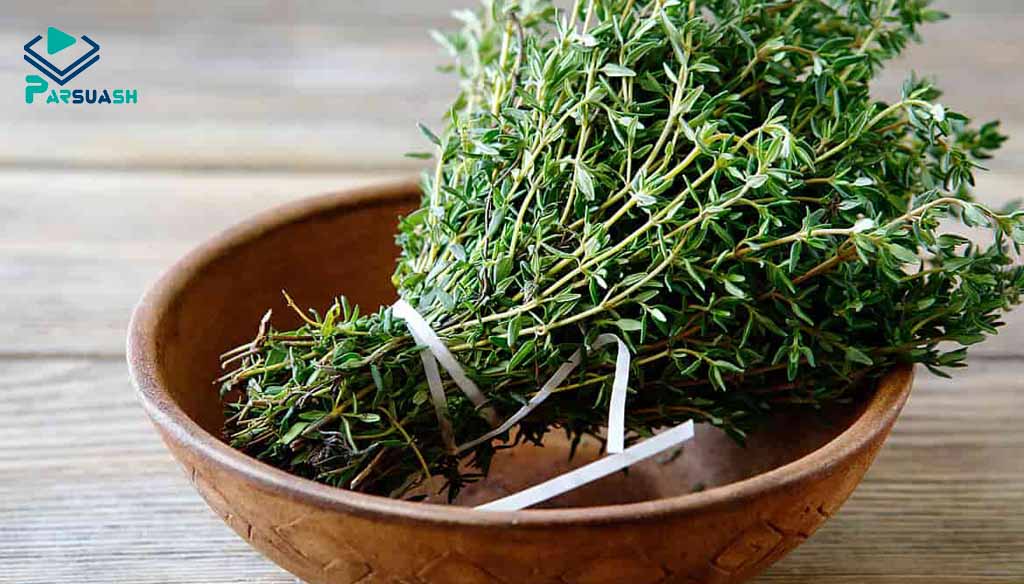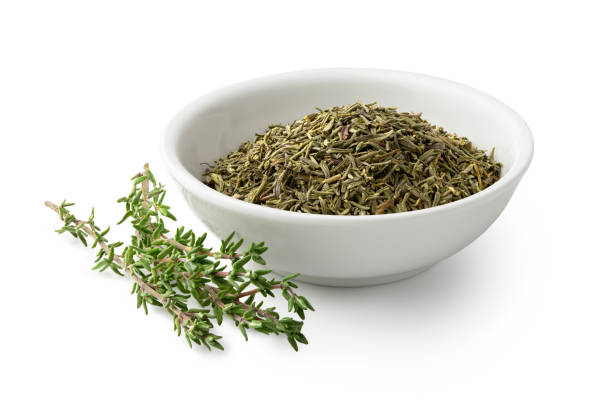
Table of Contents
Thyme is one of the aromatic medicinal plants and occupies a special place in traditional medicine. In addition to medicinal properties, this plant has many fans as a spice. Before the time of refrigeration, it was even used to protect against spoiled products and food-borne diseases. Due to the antimicrobial properties of thyme, it was also used in food to prevent foodborne illness and food poisoning. The antibacterial properties of thyme oil are used to heal wounds quickly. Nowadays, thyme is mainly used in people’s diet, and the unique benefits of this plant have a significant impact on health and longevity.
Characteristics of thyme
The thyme plant (another name of Azerba) with the English name (Thymes) and the scientific name (L. vulgaris Thymus) is a dicotyledonous plant of the mint family (Lamiaceae). The name thyme is derived from the Greek word ‘thymos’, which means courage or strength. In the first century AD thyme was used mainly as a medicinal plant, which was already mentioned in the work of Dioscorides. The origin of this plant dates back to the third geological period and comes from the Mediterranean regions, where it grows as a shrub among rocks and on the slopes of dry and mountainous areas. Wild thyme was first cultivated in Syria (areas in the eastern Mediterranean). Today, this plant is grown in various regions of the world, including Iran. Thyme is one of the most famous medicinal and spice plants, which is the second most important medicinal plant in the world after mint.
.
This plant consists of a wooden root with numerous branches that have a rough appearance and can penetrate hard soils and rocks, and it has the shape of a small shrub (bush) full of wooden branches, with leaves on the branches with small, fragrant, oval and light gray color.
.
The aroma of the extract of this plant is spicy and the fresh plant has more aroma. The number of species of this plant reaches 800 species in some reports, but the number of known species used is 350 species. The distribution area of these species is Mediterranean, European continent and Africa. In Iran, 14 species of this plant grow, 4 of which are found only in Iran. Thyme is known in the world under the international code (HS code): 091099.
Benefits of thyme and its nutritional value
Thyme is rich in vitamins, antioxidants and minerals that are very useful for human health. The plant contains large amounts of thymol, which has antiseptic and antibacterial properties. For this reason, it can prevent food contamination and treat food poisoning. In addition, carvacrol contained in thyme acts on the nerve cells of the brain, improves mood and reduces stress. Thyme oil is effective in relieving the symptoms of arthritis and gout.
.
Another property of thyme is to increase metabolism, help in slimming and lose weight. This plant has a hot and dry nature, so consuming its tea causes weight loss and slimming, especially for people with cold temperatures who are prone to obesity in the abdominal area. In addition, thyme is a natural diuretic and can remove toxins from the body. In addition, thyme is also useful for the digestive system. This plant helps to digest food quickly, relieve flatulence and constipation, and ensure the proper functioning of the digestive system. Consumption of thyme tea in the morning reduces appetite and relieves indigestion.
.
According to research, eating thyme instead of harmful spices like salt can help treat and control blood pressure. In addition, this plant regulates and improves HDL and LDL levels, as well as triglycerides, reducing the risk of heart attack.
.
Thyme is rich in the minerals calcium, potassium, magnesium, phosphorus, iron, selenium, manganese, sodium and zinc. The calcium contained in it contributes to the health of bones and strengthening their density. In addition, this plant contains large amounts of vitamins K, B9, A, E, C, B1, B2, B3, B4 and B6, all of which have effects on human health. Thyme is a rich source of vitamin A, which strengthens vision. Vitamin C contained in this plant plays a role in strengthening the body’s immune system, preventing and treating colds and flu. Due to its antiseptic and antibiotic properties, thyme is also used in the treatment of respiratory diseases, including bronchitis. Even the Greek physician Hippocrates used thyme to treat respiratory diseases. Thyme tea is used to treat sore throats, headaches and respiratory infections. Thyme essential oil is one of the 10 most famous essential oils in the world, which has antibacterial and antifungal properties and is a natural preservative for food.
.
These minerals, vitamins and antibacterial properties of thyme are very useful for the health of skin, hair, teeth and gums. It prevents premature aging of the skin, is useful in the treatment of inflammation and dryness of the skin and acne, and its oil accelerates the healing of wounds and burns. The plant is usually used as a main ingredient in the preparation of shampoos and is effective in the treatment of dandruff. The use of this oil also helps with mouth and tooth infections, and the use of this plant as a mouthwash is effective in treating gingivitis and bad breath.
.
Suggested article: Iran export potential: export of dried fruits
Types of thyme
Thyme plant has a great variety of species, but some of the species of this plant are:
.
Eurasian thyme (Thymus pannonicus): Another name for this type of mountain thyme is Hungarian thyme. Eurasian thyme grows on dry meadows and rocks, it has a special and pleasant smell, reminiscent of lemon, and is used to flavour jams and sweets.
Woolly thyme (Thymus pseudolanuginosus): Because of its structure, Thymus pseudolanuginosus is suitable for planting along walkways and traffic routes, and as a ground cover and stepping stone. Woolly thyme is a creeping plant with hairy stems (hence the name woolly thyme) and fragrant, found mainly in Europe. Woolly thyme grows easily in medium or dry soils, is resistant to human footfalls, and emits a unique fragrance in the air when touched.
Creeping Thyme (Thymus praecox): This species of thyme is a small plant that covers the ground like grass. The small and beautiful purple flowers of creeping thyme are also a beautiful and impressive sight. The unique fragrance of this plant is not only beautiful, but also attracts beneficial insects and drives away harmful insects from the garden. In the cold season, the flowers of this plant disappear, but with the onset of spring they bloom again. Woolly thyme and creeping thyme, in addition to their beauty, have medicinal properties.
Lemon thyme (Thymus pulegioides): Lemon thyme is one of the most fragrant and tasty varieties of the thyme family. This plant has broad leaves shaped like lemon leaves and is a creeping evergreen shrub with woody stems that all bloom pink or purple. Lemon thyme is very similar to the wild species (Thymus serpyllum), but this species is larger and has broader leaves than wild thyme. Due to the wonderful aroma and taste of this plant, it is widely used in cooking. The flowers of lemon thyme bloom in July and August and attract bees, which also make an important contribution to pollination in nature.
Caraway thyme (Thymus herba-barona): this plant is popularly known as black cumin thyme because it has a strong aroma similar to black cumin. The very good smell and mild pungency of cumin thyme are its most important properties, which can be used in various dishes. This type of thyme is native to Sardinia and Mallorca and can be harvested in late spring and early summer.
.

Common Thyme or Mountain Thyme (Thymus vulgaris): this species of thyme is known as the most common thyme in the world and grows in most mountainous regions of the world. Thymus vulgaris has many woody branches with yellow leaves. This plant is mainly used in cooking.
Thymus Moroderi: is a small plant from the genus Thymus. It is endemic to some areas in the southern, driest part of the province of Alicante (where it is called cantahueso or cantueso in both Spanish and Valencian), as well as to some isolated and similarly subarid sites in the adjacent Región de Murcia (Spain). The flowers of Moroderi thyme have an attractive purple color, which is why it is also used as an ornamental plant.
Thymus capitatus: Thymus capitatus is a compact, woody perennial native to Mediterranean Europe and Turkey, commonly known as cone thyme, Persian hyssop, and Spanish oregano. It is also known as Thymbra capitata. Rose thyme has climbing stems, narrow green leaves and pink or purple flowers.
Thymon (Thymus serpyllum): Known as Breckland thyme, [3] Breckland wild thyme, wild thyme, creeping thyme, or fairy thyme. This plant is a creeping dwarf evergreen shrub with woody stems and a taproot. Usually this type of thyme is not used in cooking and has a decorative aspect. This plant is native to northern Europe, Africa and western Asia and also grows in Iran.
Thymus Dena (Thymus daenensis): Thymus Dena plant is one of the native species in Iran and grows scattered in some villages of Kuhin city in Qazvin province. The heads of the flowering branches of this plant are used as tea, and its dried powder is used as a spice in food.
Species of thyme in Iran
Due to climatic conditions, Iran is suitable for cultivation of a wide range of thyme plants, and of the approximately 350 species of this plant in the world, there are 14 species in Iran, of which 4 species are native to Iran.
.
Persian thyme (Thymus persicus): is one of the native thyme species in Iran, which grows in Zanjan and West Azerbaijan provinces. This plant has climbing stems with narrow leaves and small purple flowers.
.
Carmanicus Thymus: This is also a special type of thyme in Iran. This creeping plant has narrow green leaves with small pink flowers. Carmanic thyme begins its vegetative growth in early June, and the flowers bloom in early July. This aromatic plant grows in the areas of Kerman, Yazd, Isfahan and Shahroud provinces.
.
Daenensis Thymus: Daenensis Thymus is one of the most famous thyme species in the world, it is native to Iran and has a special place in traditional medicine. The main substance in Daenensis Thymus (thymol and caracrol) has antibacterial, antifungal, antiparasitic and antispasmodic properties. This plant grows in most provinces of Iran, especially in Qazvin, Chaharmahal and Bakhtiari provinces.
.
Thymus trautvetteri: Thymus trautvetteri is a small plant and shrub with branched and woody stems, it has narrow leaves and its whole surface is covered with down. The flowers of this plant are purple in color and bloom from the end of May to the end of July. This species is compatible with semi-arid-cold climate and grows densely in the highlands of northeastern Iran (North Khorasan province).
.
Shirazi thyme (Zataria multiflora Boiss): Shirazi thyme is a domesticated and cultivated species of common thyme (mountain thyme) and is grown in southern Iran, Afghanistan, and Pakistan. Shirazi thyme, like other thyme species, has antifungal and antiparasitic properties. This type of thyme is not unique to Iran, but it is one of the most commonly consumed types of thyme in Iran, along with common thyme. The properties of Shirazi thyme are inferior to those of common thyme. Moreover, mountain thyme has stronger aroma and spicier taste than shirazi thyme, and the appearance and color of leaves are also different.
.

Thyme growing conditions
Thyme is one of those plants that are resistant to desiccation and grow well in hot, dry, sunny weather. Light plays an important role in the quality of the essential oil of this plant, so it is recommended to grow it in sunny areas and on the slopes of mountains and hills. In the cold season it can withstand some temperature, but it is not hardy and dries out.
.
Temperature: the thyme plant needs warm air to grow and is not cold resistant. The germination power of this plant slows down in the cold season. For this reason, it is recommended to use one of the following two methods for sowing: 1- plant seeds in pots 6-10 weeks before the beginning of the hot season and put them in the ground after the temperature rises or 2- plant seeds in summer when the temperature reaches 21 degrees Celsius. In addition, the aroma and flavour of thyme planted outdoors is better than in a greenhouse.
Soil: Soil is one of the most important factors for plant growth. Thyme plants can grow in any well-drained soil. They tolerate a pH of 5 to 8. Heavy and wet soils that do not contain enough nutrients prevent the plant from growing well. Soil texture also plays an important role in improving yield, so the soil must be drained.
Humidity and water: as mentioned above, the thyme plant is sensitive to waterlogging and its roots rot quickly. Thyme does not need much water and moisture, so it is recommended to plant it in deep soil, where the distance between the soil and water is greater.
Sunlight: Sunlight also plays an important role in the growth of thyme plants. This plant is sensitive to shade at the beginning of its growth and grows better and faster when exposed to strong sunlight. For this reason, it is recommended to plant the plant on sloping and inclined surfaces.
Global trade in thyme
According to the 2021 OEC site report, products of code 091099 ranked 2185th in the world with sales of $957 million. Between 2020 and 2021, exports of these products increased 3.81% from $922 million to $957 million, and their trade accounts for 0.0045% of total world trade. The total value of U.S. exports of products with code 091099 in 2022 was $748,173 thousand. Turkey ($122 million), India ($77 million), China ($67 million), South Africa ($57 million), and America ($47 million) were the largest exporters of this commodity in 2022.
.

.

.
The total value of imports of this product in 2022 was 826,957 thousand US dollars, and the largest importers are: United States (117 thousand US dollars), Germany (47 thousand US dollars), United Kingdom (43 thousand US dollars), France (35 thousand US dollars) and the Netherlands (35 thousand US dollars).
.

.

.
The map below shows which countries export or import the most of these products. In 2021, the countries with a positive trade balance were India, Turkey, South Africa, Kenya, and Spain. The countries with the most imports compared to exports of this product are also: the United States, Saudi Arabia, the United Kingdom, France and Canada.
.

Thyme growing areas in the world
The plant is native to the Mediterranean, Central and Southern Europe, and North Africa. Thyme grows and can be cultivated in much of Spain, Germany, France, Italy, Portugal, the Americas, Greece, Turkey, Iran, the Czech Republic, Slovakia, Hungary, India, and Morocco.
Thyme export statistics of Iran to the world
The value of products of group 091099 exported by Iran in 2022 was $585 thousand, which is 0.1% of the world’s export of this product, and Iran’s rank in the world’s export of this product is 64. The countries of Turkey ($116 thousand), Canada ($78 thousand) and Germany ($72 thousand) were the largest buyers or importers.
.

.

Thyme growing areas in Iran
Thyme is common in Iran mainly in the northern and western provinces. There are several species of this plant in Zagros and Alborz highlands. 11 species of the thyme family in the western provinces (Western and Eastern Azerbaijan, Chaharmahal and Bakhtiari, Hamedan, Kurdistan, Lorestan, Isfahan, Kohgiluyeh and Boyer-Ahmad), 10 species in the northern provinces (Mazandaran, Gilan, Golestan), 7 species in the center of the country (Tehran, Qazvin, Arak, Semnan and Yazd) and 3 species in Fars and Kerman provinces.
Thyme market outlook in the world
In 2019, the cosmetics sector accounts for more than 50% of the market share. People’s awareness about the unique properties of thyme, essential oil and its oil for health and beauty has increased the demand for herbal cosmetics, especially thyme. During the forecast period, the demand for cosmetics is expected to increase in Asian and Pacific markets. Due to increasing demand for natural and herbal medicines instead of chemical drugs, growth in the pharmaceutical sector for this product is also expected. In addition, in the food and beverage sector, we have a higher growth rate in this sector due to the changing dietary habits of people and the trend towards herbal supplements and healthy foods. Based on these findings, the global thyme market is expected to grow at a CAGR of 5.5% from 2022 to 2030.
